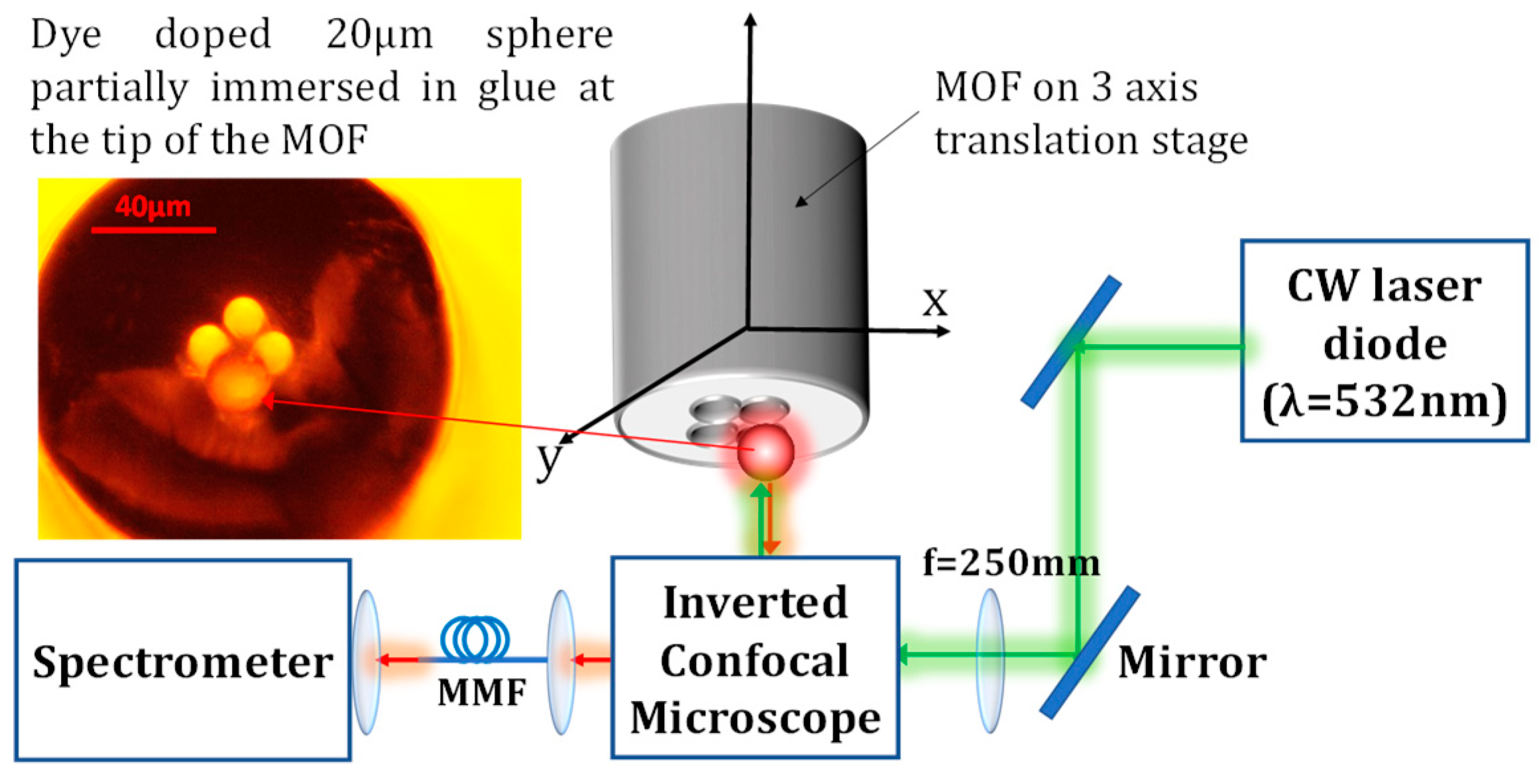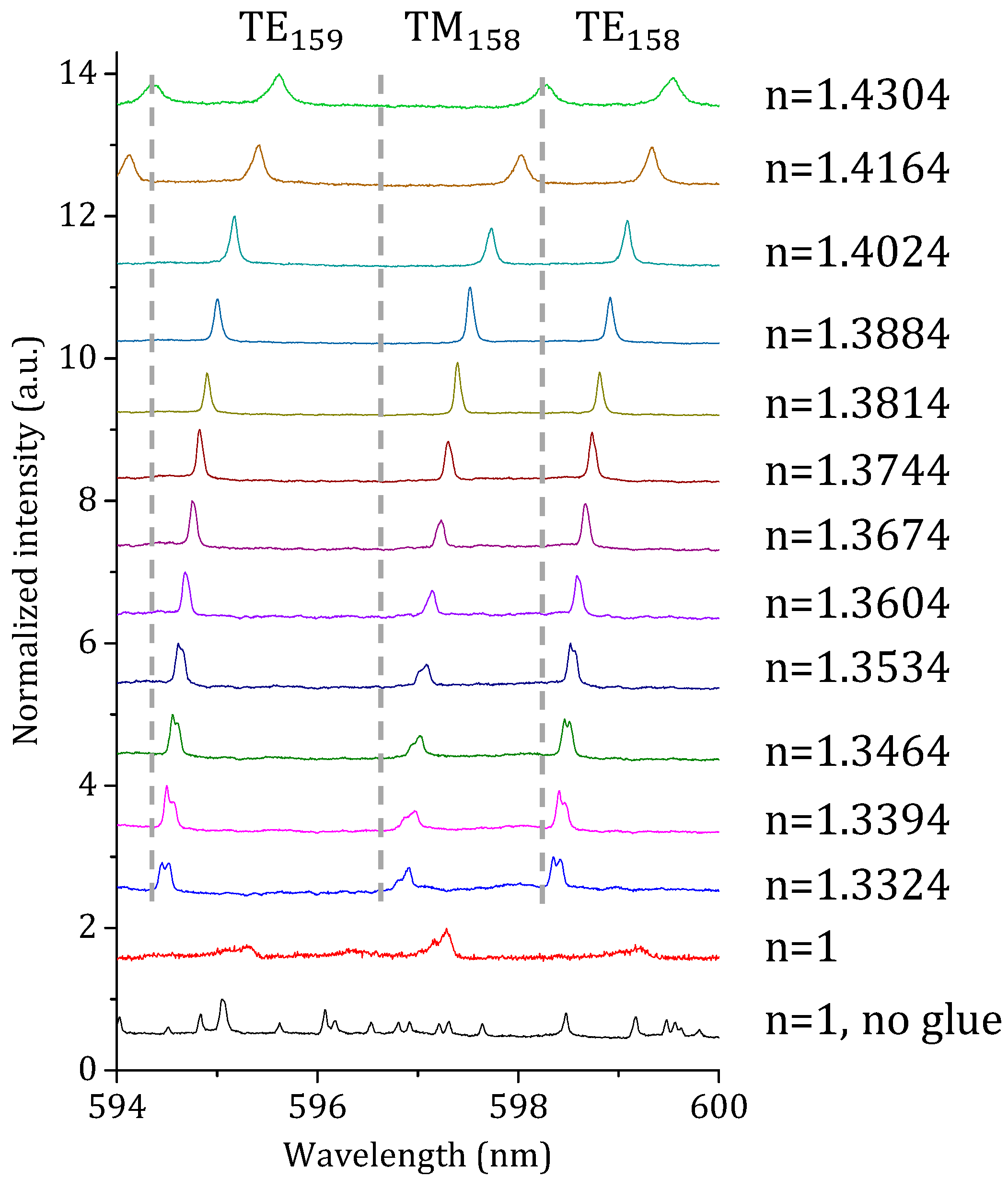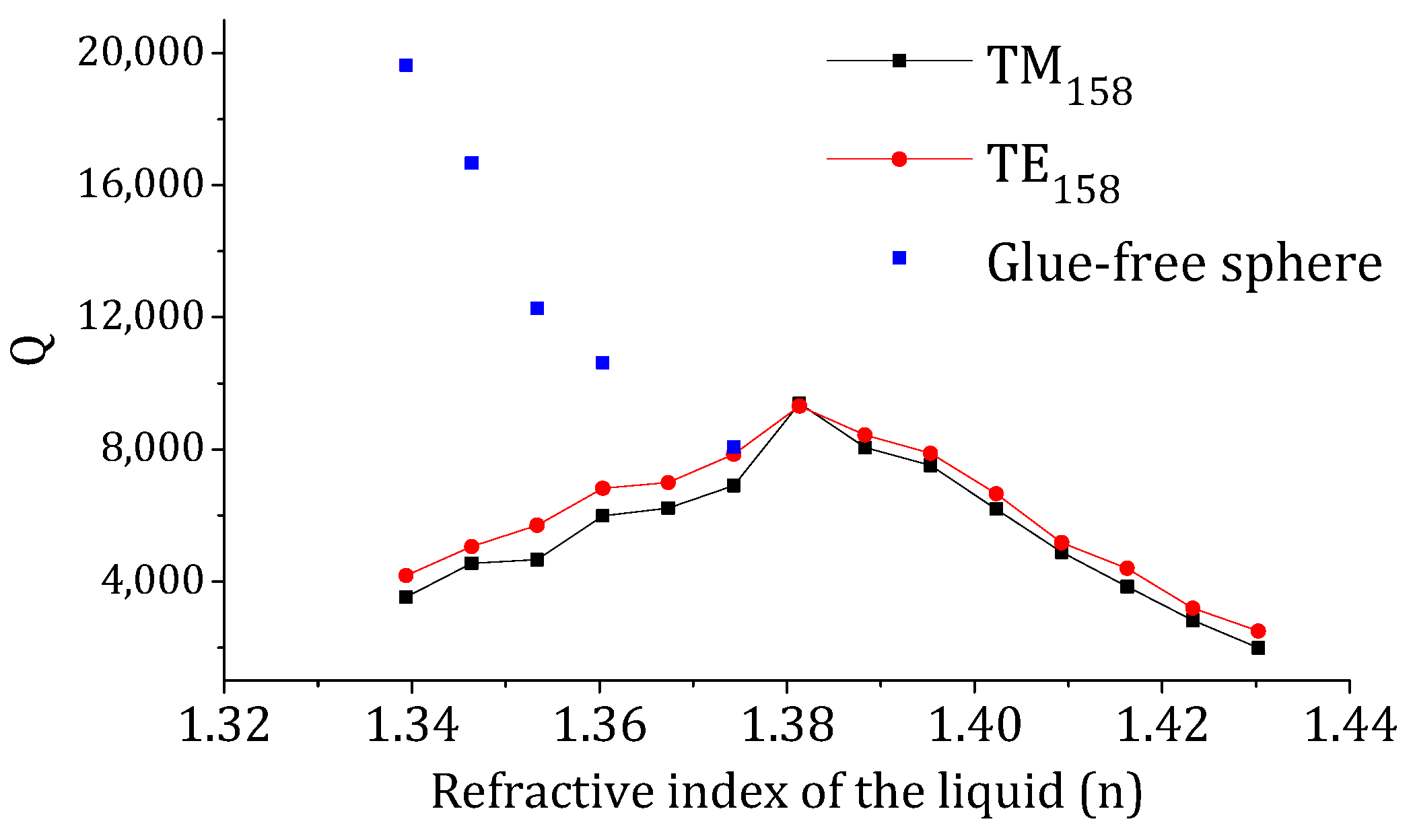Mode-Splitting for Refractive Index Sensing in Fluorescent Whispering Gallery Mode Microspheres with Broken Symmetry
Abstract
1. Introduction
2. Materials and Methods
2.1. Preparation of the Active Microsphere
2.2. Optical Setup
3. Results and Discussion
3.1. WGMs in Active Sphere Partially Covered by Glue
3.2. A Self-Referenced Approach Based on Two Split-Modes
4. Conclusions
Author Contributions
Funding
Conflicts of Interest
References
- François, A.; Zhi, Y.; Meldrum, A. Whispering gallery mode devices for sensing and biosensing. In Photonic Materials for Sensing, Biosensing and Display Devices; Springer: Berlin/Heidelberg, Germany, 2016; pp. 237–288. [Google Scholar]
- Reynolds, T.; Henderson, M.; François, A.; Riesen, N.; Hall, J.; Afshar, S.; Nicholls, S.; Monro, T. Optimization of whispering gallery resonator design for biosensing applications. Opt. Express 2015, 23, 17067–17076. [Google Scholar] [CrossRef] [PubMed]
- Vollmer, F.; Braun, D.; Libchaber, A.; Khoshsima, M.; Teraoka, I.; Arnold, S. Protein detection by optical shift of a resonant microcavity. Appl. Phys. Lett. 2002, 80, 4057–4059. [Google Scholar] [CrossRef]
- Baaske, M.D.; Foreman, M.R.; Vollmer, F. Single-molecule nucleic acid interactions monitored on a label-free microcavity biosensor platform. Nat. Nanotechnol. 2014, 9, 933–939. [Google Scholar] [CrossRef] [PubMed]
- Foreman, M.R.; Swaim, J.D.; Vollmer, F. Whispering gallery mode sensors. Adv. Opt. Photonics 2015, 7, 168–240. [Google Scholar] [CrossRef] [PubMed]
- Reynolds, T.; François, A.; Riesen, N.; Turvey, M.E.; Nicholls, S.J.; Hoffmann, P.; Monro, T.M. Dynamic self-referencing approach to whispering gallery mode biosensing and its application to measurement within undiluted serum. Anal. Chem. 2016, 88, 4036–4040. [Google Scholar] [CrossRef] [PubMed]
- Lane, S.; West, P.; François, A.; Meldrum, A. Protein biosensing with fluorescent microcapillaries. Opt. Express 2015, 23, 2577–2590. [Google Scholar] [CrossRef] [PubMed]
- Huston, A.; Eversole, J.D. Strain-sensitive elastic scattering from cylinders. Opt. Lett. 1993, 18, 1104–1106. [Google Scholar] [CrossRef] [PubMed]
- Himmelhaus, M.; Francois, A. In-vitro sensing of biomechanical forces in live cells by a whispering gallery mode biosensor. Biosens. Bioelectron. 2009, 25, 418–427. [Google Scholar] [CrossRef] [PubMed]
- Shen, B.-Q.; Yu, X.-C.; Zhi, Y.; Wang, L.; Kim, D.; Gong, Q.; Xiao, Y.-F. Detection of single nanoparticles using the dissipative interaction in a high-Q microcavity. Phys. Rev. Appl. 2016, 5, 024011. [Google Scholar] [CrossRef]
- Hu, Y.; Shao, L.; Arnold, S.; Liu, Y.-C.; Ma, C.-Y.; Xiao, Y.-F. Mode broadening induced by nanoparticles in an optical whispering-gallery microcavity. Phys. Rev. A 2014, 90, 043847. [Google Scholar] [CrossRef]
- Gorodetsky, M.L.; Pryamikov, A.D.; Ilchenko, V.S. Rayleigh scattering in high-Q microspheres. JOSA B 2000, 17, 1051–1057. [Google Scholar] [CrossRef]
- Zhu, J.; Ozdemir, S.K.; Xiao, Y.-F.; Li, L.; He, L.; Chen, D.-R.; Yang, L. On-chip single nanoparticle detection and sizing by mode splitting in an ultrahigh-Q microresonator. Nat. Photonics 2010, 4, 46–49. [Google Scholar] [CrossRef]
- He, L.; Özdemir, Ş.K.; Zhu, J.; Kim, W.; Yang, L. Detecting single viruses and nanoparticles using whispering gallery microlasers. Nat. Nanotechnol. 2011, 6, 428–432. [Google Scholar] [CrossRef] [PubMed]
- Reynolds, T.; Riesen, N.; Meldrum, A.; Fan, X.; Hall, J.M.; Monro, T.M.; François, A. Fluorescent and lasing whispering gallery mode microresonators for sensing applications. Laser Photonics Rev. 2017, 11, 1600265. [Google Scholar] [CrossRef]
- Riesen, N.; Reynolds, T.; François, A.; Henderson, M.R.; Monro, T.M. Q-factor limits for far-field detection of whispering gallery modes in active microspheres. Opt. Express 2015, 23, 28896–28904. [Google Scholar] [CrossRef] [PubMed]
- François, A.; Riesen, N.; Ji, H.; Afshar, V.S.; Monro, T.M. Polymer based whispering gallery mode laser for biosensing applications. Appl. Phys. Lett. 2015, 106, 031104. [Google Scholar] [CrossRef]
- François, A.; Reynolds, T.; Monro, T.M. A fiber-tip label-free biological sensing platform: A practical approach toward in-vivo sensing. Sensors 2015, 15, 1168–1181. [Google Scholar] [CrossRef] [PubMed]
- Teraoka, I.; Arnold, S. Theory of resonance shifts in TE and TM whispering gallery modes by nonradial perturbations for sensing applications. JOSA B 2006, 23, 1381–1389. [Google Scholar] [CrossRef]
- Francois, A.; Himmelhaus, M. Optical sensors based on whispering gallery modes in fluorescent microbeads: Size dependence and influence of substrate. Sensors 2009, 9, 6836–6852. [Google Scholar] [CrossRef] [PubMed]
- Schweiger, G.; Horn, M. Effect of changes in size and index of refraction on the resonance wavelength of microspheres. JOSA B 2006, 23, 212–217. [Google Scholar] [CrossRef]




© 2018 by the authors. Licensee MDPI, Basel, Switzerland. This article is an open access article distributed under the terms and conditions of the Creative Commons Attribution (CC BY) license (http://creativecommons.org/licenses/by/4.0/).
Share and Cite
Kang, Y.Q.; François, A.; Riesen, N.; Monro, T.M. Mode-Splitting for Refractive Index Sensing in Fluorescent Whispering Gallery Mode Microspheres with Broken Symmetry. Sensors 2018, 18, 2987. https://doi.org/10.3390/s18092987
Kang YQ, François A, Riesen N, Monro TM. Mode-Splitting for Refractive Index Sensing in Fluorescent Whispering Gallery Mode Microspheres with Broken Symmetry. Sensors. 2018; 18(9):2987. https://doi.org/10.3390/s18092987
Chicago/Turabian StyleKang, Yvonne Q., Alexandre François, Nicolas Riesen, and Tanya M. Monro. 2018. "Mode-Splitting for Refractive Index Sensing in Fluorescent Whispering Gallery Mode Microspheres with Broken Symmetry" Sensors 18, no. 9: 2987. https://doi.org/10.3390/s18092987
APA StyleKang, Y. Q., François, A., Riesen, N., & Monro, T. M. (2018). Mode-Splitting for Refractive Index Sensing in Fluorescent Whispering Gallery Mode Microspheres with Broken Symmetry. Sensors, 18(9), 2987. https://doi.org/10.3390/s18092987




